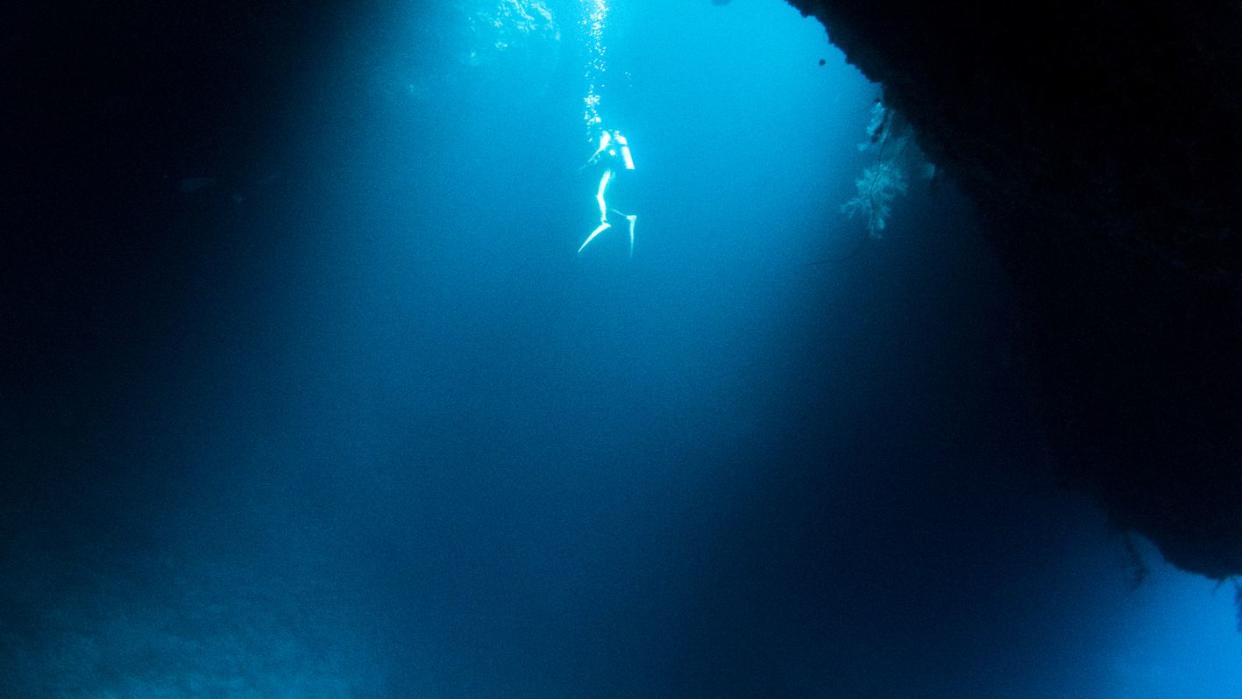Scientists Discovered the World's Deepest Blue Hole. And They Still Can't Find Its Bottom.

Over the course of millions of years, helped along by a dino-killing asteroid, geologic pockmarks known as cenotes and blue holes fill the Yucatan peninsula, providing an oasis for animal life.
In 2023, scientists discovered a massive blue hole named Taam Ja' in Chetumal Bay in Mexico, but couldn't discern its maximum depth due to acoustic interference.
Now, after further study using a water pressure-measuring instrument, the team can confirm that Taam Ja' is actually the deepest blue hole in the world—and they still haven't found its bottom.
Every year, nearly 3 million people travel to Yucatan, the central American peninsula comprising southwestern Mexico, northeastern Guatemala, and northern Belize. Tucked amongst awe-inspiring Mayan ruins and world-famous beaches are Swiss cheese-esque rock formations known locally as cenotes (say-no-tays).
Formed over millions of years due to the Earth’s steady rotation of ice ages as well as a little-understood boost from Chicxulub crater—the dino-killing asteroid that landed in the region 66 million years ago—these impressive sinkholes are a must-see destination for any Yucatan tourist. But despite this wealth of unique geography, this tropical locale now sports yet another geologic accolade—it’s officially home to the world’s largest “blue hole.”
While similar to cenotes (they’re both giant holes in the ground), blue holes are submerged and filled with seawater while the well-known cenote is inland and usually filled with freshwater—a swimmer’s paradise. Located in Chetumal Bay in the Mexican state of Quintana Roo, the Taam Ja’ (“deep water” in Mayan) blue hole was recently recognized as the deepest blue hole on the planet, beating out the previous recorder holder the Dragon Blue Hole in the south China Sea which stretches 988 below sea level.
However, scientists still don’t know by how much this newly discovered blue hole goes because, well, they haven’t reached the bottom yet. Although originally discovered in 2003 by a local diver, the hole wasn’t officially described until last year. At the time, local news teams reported the discovery as the second largest blue hole in the world, but a new study published in late April confirms that is actually the deepest, though they don’t know by how much.
“The Taam Ja’ Blue Hole (TJBH), revealed a depth of ~274 meters below sea level [899 feet] based on echo sounder mapping, momentarily positioning it as the world's second-deepest blue hole,” the authors of the study, led by a public center for scientific research El Colegio de la Frontera Sur (ECOSUR), said in a press statement. “However, echo sounding methods face challenges in complex environments like blue holes or inland sinkholes arising from frequency-dependent detection and range limitations.”
While sound usually travels better in water, the acoustic waves couldn’t penetrate farther than 900 feet, likely due to pycnocline, a layer of water where density gradients are highest and are likely to scatter acoustic waves. So, ECOSUR went with another method by traveling to the middle of the hole in late December and dropping in a water pressure-measuring instrument. This device traveled down some 420 meters below sea level (1,377 feet) before also maxing out “with no bottom yet reached,” according to the authors.
While they haven’t found the hole’s maximum depth, the probe did discover that water conditions suddenly shifted to those similarly found in the Caribbean Sea, so experts theorize that a tunnel could connect the blue hole to the wider ocean.
The only way to find out for sure is to send robots on a search to fully explore Taam Ja’ and its many mysteries, which could very well include fascinating forms of life. Although cenotes and blue holes can be incredibly dark places with not a lot of oxygen, they’ve also been known to be home to healthy ecosystems.
In other words, the exploration of the world’s deepest blue hole is only just beginning.
You Might Also Like
